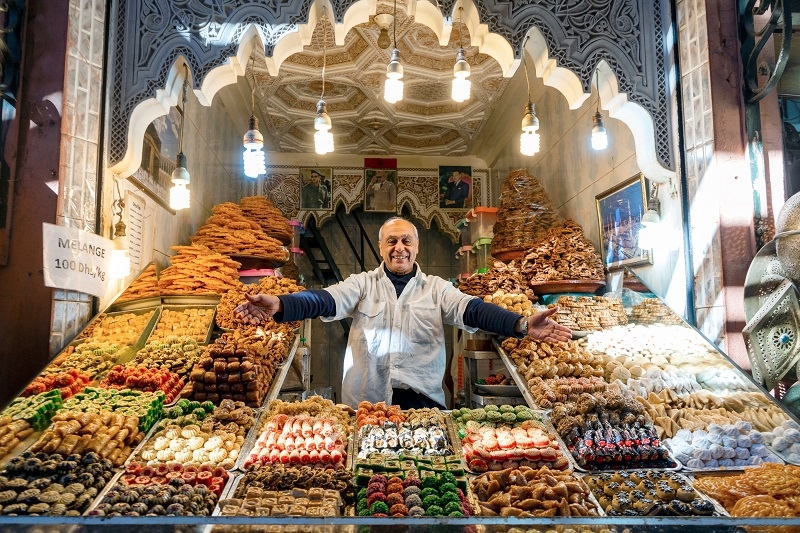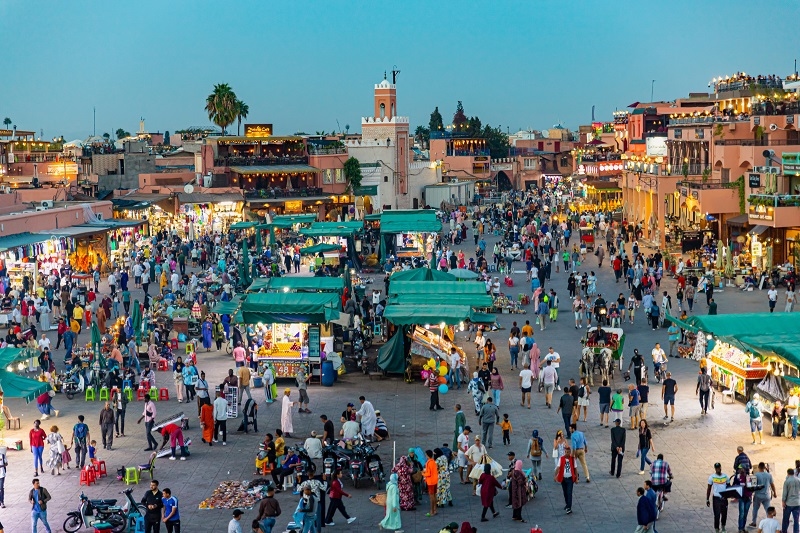
Morocco stands out among the world's gastronomic adventures as a veritable feast for the senses. From the busy souks of Marrakech to the peaceful Berber kitchens inside the Atlas Mountains, this Moroccan food travel guide transports you on a gastronomic adventure. Moroccan delicacies, which are rich in spices, loaded with history, and deeply ingrained in culture, are more than just what's on the plate; they're about the stories that lie behind each bite.
This book is your go-to resource for Moroccan cultural food reviews, whether you're enjoying traditional tagine and couscous dishes, eating fiery avenue feasts in Marrakech, or discovering the secrets of the country's delicious delicacies. Let’s begin the journey—your flavor buds will thank you.
Centuries of history, an alternative way of life, and international fusion shape the foundation of this Moroccan food tour manual. French, Andalusian, Arab, and Berber culinary influences all blend to provide something completely authentic.
As you explore medieval medinas, the air is packed with the scents of saffron, cumin, cinnamon, preserved lemon, and harissa. A mystery food stand, a fragrant bakery, or a welcoming kitchen awaits you in the quiet of every alley. Moroccan delicacies invites you to gradual down, be part of, and revel in its tremendous stews and flaky pastries.
Let's discover in element the ingredients, neighborhoods, and customs that define these amazing delicacies.
No Moroccan food journey guide is complete without highlighting its maximum iconic duo: tagine and couscous dishes.
Cooked in a cone-shaped clay pot, tagine is both a cooking approach and a meal. It’s a sluggish-braised stew of meat or greens, enriched with spices, herbs, and dried end result.
Popular Tagine Variations:
Traditionally served on Fridays after prayers, couscous is crafted from tiny steamed semolina grains. It’s generally topped with lamb, root veggies, and a ladle of broth.
These tagine and couscous dishes reflect Morocco’s soul—gradual, deep, and communal. Learning to cook them is one of the most enriching cultural food stories in Morocco.
If there’s one place to experience Moroccan meals in its wildest, most flavorful form, it’s the bustling street meals in Marrakech. Jemaa el-Fnaa, the town’s important rectangular, transforms each night into a scorching grocery store.
Don’t leave out the snail soup carriers for a bold (but especially delicious) chew, or the famous orange juice stalls for a fresh palate cleanser.
These colourful scenes deliver your Moroccan meals tour guide to lifestyles—alive with storytelling, tradition, and the heartbeat of regular Moroccan existence.
You don’t have to fly to Fez or Casablanca to enjoy Moroccan cuisine. Here are some satisfactory Moroccan recipes you can try in your kitchen:
Ingredients:
A rich, warming dish perfect for weekend gatherings. Add carrots, zucchini, and chickpeas over steamed couscous and simmered lamb broth.
A combo of Chinese gunpowder inexperienced tea, fresh spearmint, and sugar, poured from high to create a frothy delight. It’s more than a drink—it’s a ritual of welcome.
Mastering the high-quality Moroccan recipes brings the cultural meal experiences in Morocco right to your kitchen.
Food in Morocco isn’t simply fed on—it’s celebrated. The satisfactory way to apprehend the culture is to live through its culinary rituals.
In rural villages and important towns, women’s cooperatives provide hands-on cooking training where you’ll discover ways to make conventional tagine and couscous dishes, breads, and chocolates.
These classes offer not simply food but insight into family life, gender roles, and Moroccan hospitality—genuine cultural meal experiences in Morocco you’ll never forget.
Take a tour of spice stores with a man who explains the differences between cumin mixes and Ras el Hanout. Recognize how traditional Moroccan cuisine is altered by spices.
Eat together, bake bread in clay ovens, and gather materials to learn about the Amazigh (Berber) subculture. Without it, your guide to Moroccan cuisine would be incomplete.
These evaluations provide you more than just flavors; they give you a sense of community.

Morocco is a culinary mosaic. What you eat in Tangier will be different from what you find in Essaouira or Fez. Here’s a nearby picture:
These nearby contrasts make any Moroccan food tour guide even greater compelling—you’ll want multiple experiences to taste all of it.
Spices are the thrashing heart of Moroccan cuisine—not for warmth, but for depth.
Beyond taste, spice usage in Morocco is ritualistic. It reflects memory, identity, and even social status. Preparing your family tagine is more than cooking—it’s an act of affection, lineage, and legacy.
Ready to discover? Here are vital suggestions from your Moroccan meals tour manual:
Let's make a sample seven-day Moroccan food guide:
This itinerary blends culinary exploration with unforgettable cultural food stories in Morocco.
This Moroccan food travel guide is more than a listing of meals—it’s an invite to taste history, embrace tradition, and forge new memories via flavor.
From tagine and couscous dishes to scorching road food in Marrakech, from mastering the high-quality Moroccan recipes to diving into intimate cultural meals reports in Morocco, the adventure will linger long after your closing bite.
So pack your food, open your heart, and put together for one of the most delicious adventures of your life.
This content was created by AI